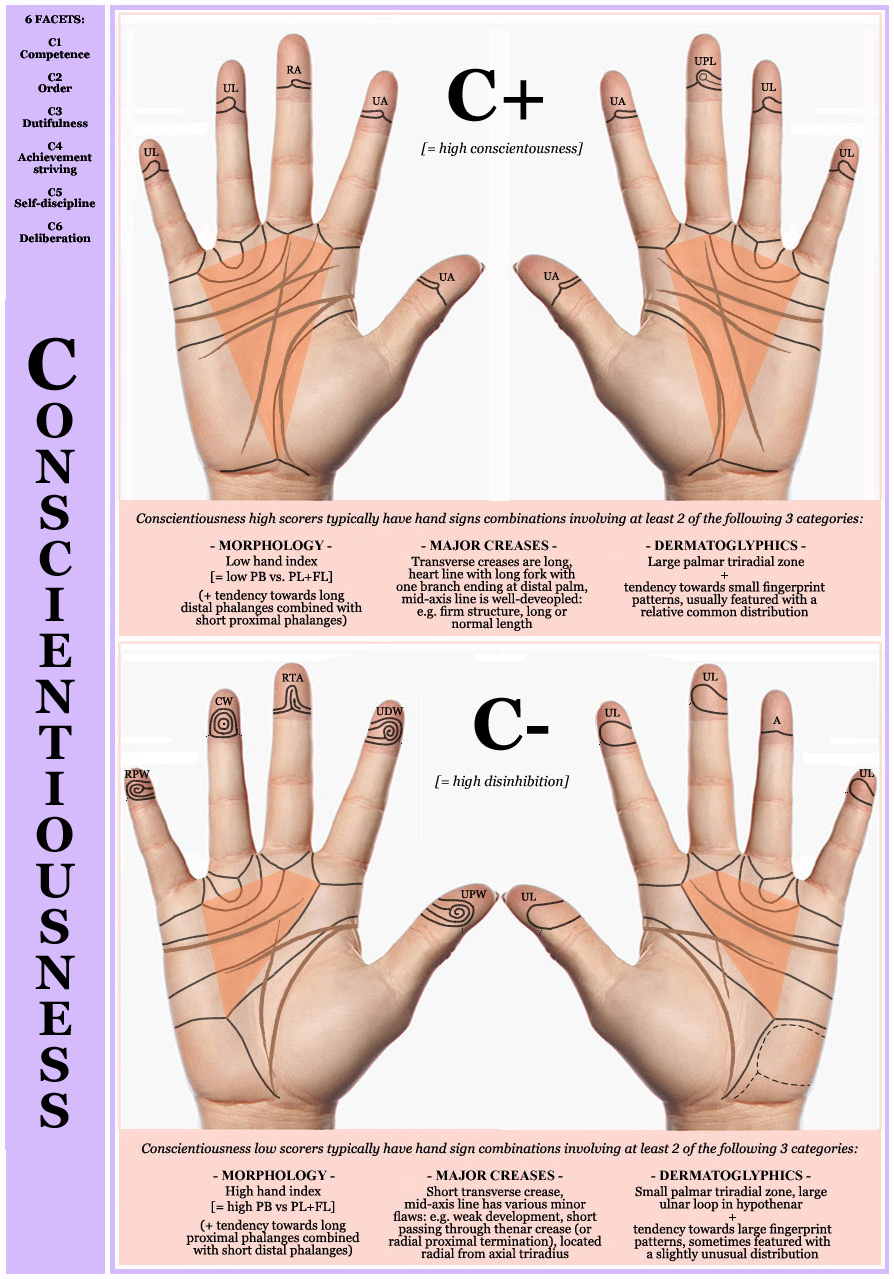|
- Publication date: october 16, 2016 (last update: may 23, 2017) - Hand Constellations in
|
|
|
The significance of 4 hand factors for
the Big Five personality dimension Conscientiousness
- Conscientiousness HIGH scorers (C+) typically exhibit constellations that involve: CONTRACTION (-) in terms of relative hand width and/or fingerprints, and EXPANSION (+) of palmar dermatoglyphics and/or major palmar lines;
- Conscientiousness LOW scorers (C-) typically exhibit constellations that involve: EXPANSION (+) in terms of relative hand width and/or fingerprints, and CONTRACTION (-) of palmar dermatoglyphics and/or major palmar lines.
• Hand factor 1: HAND INDEX (= ratio of hand breadth versus hand length)
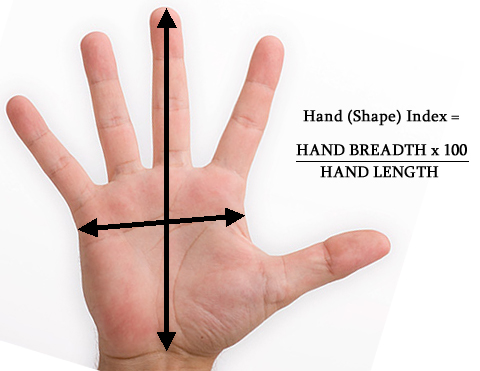 The hand index represents a commonly used measure for the overall hand shape. In the field of biometrics the hand index is usually defined in terms of the ratio between palm breadth (measured at the metacarpals) to the sum of finger length & palm length (measurement of finger length is done seperately from palm length in order to avoid arbitrary variations due to leaning of fingers).
The hand index represents a commonly used measure for the overall hand shape. In the field of biometrics the hand index is usually defined in terms of the ratio between palm breadth (measured at the metacarpals) to the sum of finger length & palm length (measurement of finger length is done seperately from palm length in order to avoid arbitrary variations due to leaning of fingers).
Hand index is know to vary among males and females: females tend to have slightly more slender hands, resulting in that the hand index typically is about 1 point lower in females compared to males (Napier, 1980). Hand index is also known to vary slightly among nations (e.g. Asians are generally known to have slender, narrow hands), and hand shape is also known to vary very significantly among various genetic populations (e.g. low index is very common in Marfan syndrome, high hand index is very common in Down syndrome, fragile-X syndrome and extremely high hand index is typically seen in achondroplasia - the most common form of dwarfism). Also, 2013 results reported by the author suggest that extraverts show a significant tendency to have a +1.2 point higher hand index compared to introverts.
In the current study, hand index has been measured for each hand separately with ruler measurements for palm breadth vs finger length + palm length ratio. The average hand index for the full population [N=102] is 44.20; average male [N=26] hand index is 45.05, average female [N=76] hand index is 43,90.
For high scorers [C+: N=46] on the Big Five personality dimension Conscientiousness the average hand index is 43,56; for low scorers [C-: N=56] the average hand index is 44,72. This difference suggests that high scorers (C+) typically tend to have relatively narrow palms, while low scorers (C-) typically tend to have relatively broad palms; this tendency is significant in terms of Person correlation coëfficient for the full population [p<0.01], and has also been observed in both the female population [p<0.01] and the male population [N.S.].
Also, 8 out of the 46 C+ scorers (= 17,4%) have a very small hand index in one or both hands that is smaller than all individual C- scorers [hand factor 1A assessment score = +1]; 12 out of the 56 C- scorers (= 21,4%) have a very large hand index in one or both hands that is larger than all individual C+ scorers [hand factor 1B assessment score = -1]. This suggests that in the studied population it appears that almost 20% of the subjects can potentially be identified successfully with the hand index. In order to arrive at a permanent assessment for individual cases the other 3 hand factors need to be taken into consideration as well; the result is pretty impressive (see the additional comment below + the details reported for individual cases in the table inside the final paragraph).
FINALLY, HOW ABOUT USING HAND FACTOR 1 COMBINED WITH THE CONTROL-MECHANISM OFFERED BY THE OTHER THREE HAND FACTORS?:
- In all 8 C+ scorers featured with a very small hand index the other 3 hand factors produce multiple confirming clue; in only of these C+ scorers [case 18C+] the other hand factors did produce a single contradictive clue (combined with 3 confirming clues, leaving the impression that the single contradictive clue was neutralized by a total of 4 confirming clues).
- In all 12 C- scorers featured with a very large hand index the other 3 hand factors produce multiple confirming clues; in only in 1 of these C- scorers [case 18C-] the other hand factors did produce a single contradictive clue (combined with 3 confirming clues, leaving the impression that the single contradictive clue was neutralized by a total of 4 confirming clues).
The overall implication is that starting from hand factor 1 and using then the other three hand factors as a control-mechanism, almost 20 percent of the full population (= 8 out of 46 C+ scorers & 12 out of 56 C- scorers) can be assessed correctly.
• Hand factor 2: FINGERPRINTS
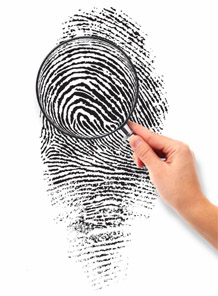 A preceding 2016 study has indicated how fingerprint combinations may provide a clue for the Big Five dimensions Extraversion & Neuroticism. In the current study, fingerprints have been assessed according the 18 pattern types described in the preceding study. Most of the results give the impression that fingerprints tend to show a tendency towards CONTRACTION (-) in C+ scorers, and a tendency towards EXPANSION (+) in C- scorers.
A preceding 2016 study has indicated how fingerprint combinations may provide a clue for the Big Five dimensions Extraversion & Neuroticism. In the current study, fingerprints have been assessed according the 18 pattern types described in the preceding study. Most of the results give the impression that fingerprints tend to show a tendency towards CONTRACTION (-) in C+ scorers, and a tendency towards EXPANSION (+) in C- scorers.
HIGH SCORERS (C+):
For high scorers [C+: N=46] on the Big Five personality dimension Conscientiousness three clusters of fingerprint combinations have been identified; cluster 1 and the first element of cluster 2 can be recognized to represent a tendency towards CONTRACTION, which refers to the presence of small fingerprint pattern types (e.g. arches represent the smallest possible pattern type); also, cluster 1 and 3 indicate that C+ scorers are often featured with a relatively common distribution of pattern types. In total 17 C+ scorers (= 37,0%) have at least one of the variants described by the clusters 1 to 3, including 4 C+ scorers who have two variants. A more detailed summary for each cluster is described below:
* Fingerprint cluster 1 (indicative for C+):
- 2A1a: both thumbs or both index fingers have a non-radial arch-related pattern variant, combined on at least 3 out of 4 fingers with a mirrored pattern in both hands; present in 6 C+ scorers, 0 C- scorers [hand factor 2A1a assessment score = +1].
- 2A1b: 6 or more fingers have an arch-related pattern; present in 3 C+ scorers, 0 C- scorers [hand factor 2A1b assessment score = +1].
- 2A1c: ulnar arch and/or ulnar tented arch patterns combined with ulnar loops on all other fingers; present in 3 C+ scorers, 0 C- scorers [hand factor 2A1c assessment score = +1].
* Fingerprint cluster 2 (indicative for C+):
- 2A2: a small (non-extralimital) radial pattern in the left hand not involving the index finger; present in 4 C+ scorers, 0 C- scorers [hand factor 2A2 assessment score = +1].
* Fingerprint cluster 3 (indicative for C+):
- 2A3: a pocket loop on the middle finger; present in 4 C+ scorers, 0 C- scorers [hand factor 2A3 assessment score = +1].
LOW SCORERS (C-):
For low scorers [C-: N=56] on the Big Five personality dimension Conscientiousness three other clusters of fingerprint combinations have been identified; cluster 4 + the first element of cluster 5 can be recognized to represent a tendency towards EXPANSION, which refers to the presence of (large) whorl-related fingerprint pattern types (extralimital whorl pattern with triradii located outside the fingerprint represent the largest possible fingerprint pattern type); cluster 5 and 6 indicate that C- scorers are also often featured with an atypical distribution of pattern types. In total 28 C+ scorers (= 50,0%) have at least one of the variants described by clusters 4 to 6, including 10 C+ scorers having two variants and 1 C+ scorer even has three variants. A more detailed summary for each cluster is described below:
* Fingerprint cluster 4 (indicative for C-):
- 2B4a: a radial whorl-related pattern with both triradii extralimital; present in 7 C- scorers, 0 C+ scorers [hand factor 2B4a assessment score = -1].
- 2B4b: sum of whorl-related variants and extralimital patterns is 9 or higher; present in 4 C- scorers, 0 C+ scorers [hand factor 2B4b assessment score = -1].
* Fingerprint cluster 5 (indicative for C-):
- 2B5a: whorl-related patterns combined with arch-related patterns; present in 8 C- scorers, 0 C+ scorers [hand factor 2B5a assessment score = -1].
- 2B5b: arch-related pattern on the middle-, ring- and/or pinky finger, without the presence of an arch-related pattern in the index finger or thumb in the same hand; present in 6 C- scorers, 0 C+ scorers [hand factor 2B5b assessment score = -1].
- 2B5c: arch-related pattern on the ring finger combined with an ulnar loop on the middle finger; present in 3 C- scorers, 0 C+ scorers [hand factor 2B5c assessment score = -1].
* Fingerprint cluster 6 (indicative for C-):
- 2B6a: radial variant in the right hand on the pinky and/or ring finger; present in 7 C- scorers, 0 C+ scorers [hand factor 2B6a assessment score = -1].
- 2B6b: a radial tented arch (on the index- or middle finger); present in 6 C- scorers, 0 C+ scorers [hand factor 2B6b assessment score = -1].
Fingerprint clusters 1 to 6 suggest that in the studied population 45% of the subjects can potentially be identified successfully with the fingerprints. In order to arrive at a permanent assessment for individual cases the other three hand factors need to be taken into consideration as well; the result is again pretty impressive (see the additional comment below + the details reported for individual cases in the table inside the final paragraph).
FINALLY, HOW ABOUT USING HAND FACTOR 2 COMBINED WITH THE CONTROL-MECHANISM OFFERED BY THE OTHER THREE HAND FACTORS?:
- In 15 out of the 17 C+ scorers who have fingerprints that meet the requirement described by clusters 1 tot 3, the other 3 hand factors produce at least 1 confirming clue and in only two of these cases the other hand factors also produce a single contradictive clue; the two C+ scorers where the other three hand factors did not produce a confirming clue a contradictive clue is also missing.
- In 20 out of the 28 C- scorers who have fingerprints that meet the requirement described by the clusters 4 to 6, the other 3 hand factors produce at least 1 confirming clue and in only one of them these other hand factors also produce a single contradictive clue (case 41C-, this concerns one of the subjects who have 2 fingerprint clues); 6 out of this group of 28 C- scorers where the other three hand factors did not produce a confirming clue a contradictive clue is also missing (2 of these subjects have 2 fingerprint clues); and finally there are two subjects in this group of 28 C- scorers where the other three hand factors produce only a contradictive clue (in case 13C- this concerns only a weak contradictive clue, and in case 50C- this concerns a modest contradictive clue but this concerns the single subject that has 3 confirming fingerprint clues).
The overall implication is that starting from hand factor 2 and using then the other three hand factors as a control-mechanism, about 45 percent of the full population (= 17 out of 46 C+ scorers & 28 out of 56 C- scorers) can be assessed correctly.
• Hand factor 3: PALMAR DERMATOGLYPHICS
In the present study, the (relative) size of the 'palmar triradial zone' - see picture displayed below - has been identified to represent a major factor in order to discriminate in the perspective of the Big Five personality dimension Conscientiousness high scorers (who typically tend to have a relatively large palmar triradial zone) from low scorers (who typically tend to have a relatively small palmar triradial zone), and vice versa.
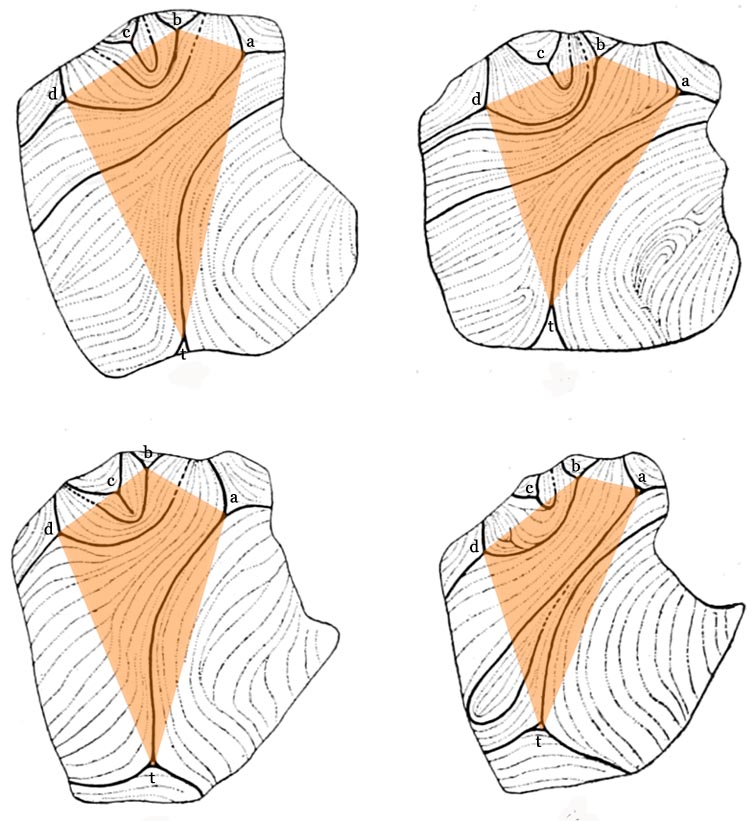
The size of the palmar triradial zone has been assessed with ruler measurements involving two specific triradial distances: 1 - the distance between triradius a (located below the index finger) & triradius d (located below the pinky finger); and 2 - the distance between triradius b (located below the middle finger) and axial triradius t (located inside the hypothenar zone near the mid-axis - this triradius can fundamentally be understood to represent a feature associated with the thumb just like the triradii a, b, c and d can be understood featured with in respective the index-, middle-, ring- and pinky finger). Other triradii have not been considered in the measurements.
Especially the ratio between the sum of palmar triradial distance ad and tb and the sum of the palm breadth [PB] and palm length [PL] has been identified as one of the most significant measures for hand factor 3. The results for this measure show a parallel with the results involving the hand index (= hand factor 1), including featured with a level of significance that is even slightly higher: high scorers (C+) typically tend to have relatively large palmar triradial zone relative to the hand size, while low scorers (C-) typically tend to have a relatively small palmar triradial zone relative to the hand size; these tendencies are significant in terms of Person correlation coëfficient for the full population [p=0.001], and are present in both the female population [p<0.016] and the male population [p<0.004]. The average value for C+ scorers is 75,18; the average value for C- scorers is 72,36.
Interestingly, in the perspective of males vs. females the relative size of the palmar triradial zone also shows a similar tendency as seen in the hand index (males tend to have higher values than females): the average value for this measure in the full population [N=102] is 73,55; average value for males [N=26] is 74.52, average value for females [N=76] is 73,22.
HIGH SCORERS:
Especially C+ scorers meet one or more of the following three criteria related to the palmar dermatoglyphics (indicative for C+):
- 3Aa: ratio between the summarized distance between triradius a & d [ad] and distance triradius b and axial triradius t [bt], and summarized palm breadth [PB] and palm length [PL] is relatively large, males: ratio > 0,78, females: ratio > 81; present in 3 C+ scorers, 0 C- scorers [hand factor 3Aa assessment score = +1].
- 3Ab: the following 3 criteria are met based on average for both hands together: PB/FL<0.98 & PB/PL<0.74 & ad/PB>68; present in 1 C+ scorers, 0 C- scorers [hand factor 3Ab assessment score = +1].
- 3Ac: at least 8 out of 10 requirements are met based on the following 5 criteria for each hand separately: PB/FL<0.95 & PB/PL<0.75 & atd<40 & ad/PB>64 & tb/PB>1,00 (without the presence of strong contradictions in the missing requirements based on the related 2nd guideline for the C- scorers); present in 10 C+ scorers, 0 C- scorers [hand factor 3Ac assessment score = +1].
- 3Ad: in the right hand the virtual palmar triradial line bt crosses the thenar line & bt is also located radial from the mid-axis line; present in 5 C+ scorers, 0 C- scorers [hand factor 3Ad assessment score = +1].
HIGH SCORERS:
Especially C- scorers meet one or more of the following six criteria related to the palmar dermatoglyphics (indicative for C-):
- 3Ba: ratio between the summarized distance between triradius a & d [ad] and distance triradius b and axial triradius t [bt], and summarized palm breadth [PB] and palm length [PL] is relatively small (males: ratio < 0,70, females: ratio < 66); present in 10 C- scorers, 0 C+ scorers [hand factor 3Ba assessment score = -1].
- 3Bb: based on both hands summarized at least 8 out of 10 requirements are met based on the following 5 criteria: PB/FL>1,02 & PB/PL>0,82 & atd>40 & ad/PB<65 & tb/PB<1,00 (without the presence of strong contradictions in the missing requirements based on the related 2nd guideline for the C+ scorers); present in 7 C- scorers, 0 C+ scorers [hand factor 3Bb assessment score = -1].
- 3Bc: based on average for both hands together the following 3 criteria are met: PB/FL>1,01 & PB/PL>0,81 & ad/PB<66; present in 10 C- scorers, 0 C+ scorers [hand factor 3Bc assessment score = -1].
- 3Bd: based on average for both hands together the following 3 criteria are met: ad/PB<62.5 & PB/PL<78; present in 6 C- scorers, 1 C+ scorers [hand factor 3Bd assessment score = -1].
- 3Be: presence of a high positioned axiale triradius in the upper half of the hypothenar zone, featured without any hypothenar pattern (no loop, no whorl); present in 7 C- scorers, 0 C+ scorers [hand factor 3Be assessment score = -1].
- 3Bf: presence of a very large unlar loop in the hypothenar zone, featured with a high positioned axial triradius plus a normal positioned axial triradius; present in 5 C- scorers, 0 C+ scorers [hand factor 3Bf assessment score = -1].
The criteria above suggest that in the studied population about 46% of the subjects (17 C+ scorers + 30 C- scorers) can be identified successfully with the palmar dermatoglyphics; however, 1 other subject (C+ scorer) is identified incorrect based on this hand factor in isolation. In order to arrive at a permanent assessment for individual cases the other three hand factors need to be taken into consideration as well; the result is again impressive (see the additional comment below + the details reported for individual cases in the table inside the final paragraph).
FINALLY, HOW ABOUT USING HAND FACTOR 3 COMBINED WITH THE CONTROL-MECHANISM OFFERED BY THE OTHER THREE HAND FACTORS?:
- In 13 out of the 17 C+ scorers who have palmar dermatoglyphics that meet the requirement described by the three criteria indicative for high Conscientiousness, the other 3 hand factors produce at least 1 confirming clue and in only two of them these other hand factors also produce a contradictive clue but the weight of these contradictive clues has in these individuals less weight than the summarized weight of the confirming signs; in two of three C+ scorers where the other three hand factors did not produce a confirming clue a contradictive clue is also missing and the one C+ scorer who also only has a contradictive clue this contradictive clue has less weight than the confirming clue; finally: the single C+ scorer that has only a contradictive clue for hand factor 3 the other three hand factors produce 3 clues indicative for high Conscientiousness.
- In 24 out of the 30 C- scoers who have palmar dermatoglyphics that meet the requirement described by the three criteria indicative for high Conscientiousness, the other 3 hand factors produce at least 1 confirming clue and in only three of these subjects these other hand factors also produced at least a single contradictive clue (however, in two of these subjects this involves a contradictive clue that relates to only one hand while for both cases there are clues that apply to both hands indicative for high Conscientiousness; the third case has a single contradictive clue for each hand, but this subject also have multiple clues for both hands indicative for high Conscientiousness); in four cases which did not produce a confirming clue for the other three factors a contradictive clue is also missing; finally, in two C- cases with a confirming clue for hand factor 3 the other three hand factors have only produced a contradictive clue with relately low weight (1 of these subjects has two clues for hand factor 3 indicative for high Conscientiousness).
• Hand factor 4: MAJOR PALMAR LINES
In the present study, the length development of some major palmar lines (including the two transversal lines & the mid axis line) has been identified to represent a major factor in order to discriminate in the perspective of the Big Five personality dimension Conscientiousness high scorers from low scorers, and vice versa. A few other factors related to the lines have been identified as well.
HIGH SCORERS:
Especially C+ scorers meet one or more of the following three criteria related to the major palmar lines (indicative for C+):
- 4Aa: both transversal lines are relatively long: they progress both outside the horizontal ad-axis of the upper palmar triradial zone (the zone is here described to end at a vertical plane located at a right angle to the virtual ad-axis); present in 25 C+ scorers, 7 C- scorers [hand factor 4Aa assessment score = max. +0,5 for each hand].
- 4Ab: distal transverse line has two long splitting branches, where one branch ends very near the distal border between the index- and middle finger and the other branch ends beyond the virtual mid-axis of the index finger; present in 14 C+ scorers, 0 C- scorers [hand factor 4Ab assessment score = max. +0,5 for each hand].
- 4Ac: considerable R-L asymmetry for the radial termination of the lower transverse line and the thenar crease: one hand does have a connection, the other hand doesn't; present in 14 C+ scorers, 1 C- scorer [hand factor 4Ac assessment score = +1].
LOW SCORERS:
Especially C- scorers meet one of the following two criteria related to the major palmar lines (indicative for C-):
- 4Ba: both transversal lines are relatively short: they do not progress outside the horizontal ad-axis of the palmar triradial zone (the zone is now described to end at a vertical plane positioned at a right angle to the ad-axis); present in 27 C- scorers, 4 C+ scorers [hand factor 4Ba assessment score = max. -0,5 for each hand].
- 4Bb: mid-axis line (in palmistry a.k.a. the 'fate line') constellation with the presence of at least 4 of the folowing 7 features in each hand, or 5 features in one hand: [1] weak development in terms of structure & length is obvious, [2] core ends before (or at) lower transverse line, [3] it's core clearly becomes weaker above lower transverse line, [4] missing above the upper transverse line, [5] crosses the thenar line, or a proximal progression directed towards the radial side, [6] full line is located above the termination of the thenar line without touching it, [7] full line is located at the radial side of the axial triradius; present in 19 C- scorers, 0 C+ scorers [hand factor 4Bb assessment score = -1].
The results above imply that in the studied population about 66% of the subjects (34 high scorers + 36 low scorers) can be identified successfully with the palmar dermatoglyphics; however, 9 other subjects are identified incorrect based on this hand factor in isolation. In order to arrive at a permanent assessment for individual cases the other three hand factors need to be taken into consideration as well; the result is again pretty impressive (see the additional comment below + the details reported for individual cases in the table inside the final paragraph).
FINALLY, HOW ABOUT USING HAND FACTOR 4 COMBINED WITH THE CONTROL-MECHANISM OFFERED BY THE OTHER THREE HAND FACTORS?:
- In 23 out of the 34 C+ scorers who have major palmar lines that meet at least one of the three major line requirements, the other three hand factors produce at least 1 confirming clue and in only one of them these other hand factors also produce a single contradictive clue; in 10 of the C+ scorers where the other 3 hand factors do not produce a confirming clue a contradictive clue is also missing, and finally: in 2 out of the 3 C+ scorers that have a single (small) contradictive clue for hand factor 4 the other three hand factors produce at least one relatively stronger clue indicative for high Conscientiousness, and in 1 out the 3 C+ scorers (case 45C+) that have a strong contradictive clue for hand factor 4 the other three hand factors produce multiple clues indicative for high Conscientiousness.
- In 28 out of the 36 C- scorers who have major palmar lines that meet at least one of the two major line requirements, the other 3 hand factors produce at least 1 confirming clue and in none of them these other hand factors produce a single contradictive clue; in 8 of the C- scorers where the other 3 hand factors do not produce a confirming clue a contradictive clue is also missing; and finally: in the 8 C- scorers that have a contradictive clue for hand factor 4 the sum of all four hand factors together produce a clue indicative for low Conscientiousness.
The overall implication is that starting from hand factor 4 and using then the other three hand factors as a control-mechanism, almost 69 percent of the full population (= 34 out of 46 C+ scorers & 36 out of 56 C- scorers) can be assessed correctly.
The results for the 4 hand factors combined!
The table below present a summary of the hand factors that have been identified in each of the 102 subjects included in this study. Beyond the 4 hand factors that have been described in the preceding paragraphs, another more complex constellation has been identified which has been observed among 6 C+ scorers, including all 5 C+ scorers who have total score of 0 based on the 4 hand factors. This complex constellation sort of represents a consistent tendency in the perspective described in this study based on the 4 hand factors, because it suggests that C+ scorers may also show a tendency towards EXPANSION (+) of palmar dermatoglyphics in terms of the amount of palmar patterns - combined with normal tendencies in the developement of the major hand lines (a full description of this more complex constellation is presented below the table).
When this complex constellation is accepted to represent a 5th hand factor in this study then it becomes possible to discriminate all C+ scorers (where all total scores become positive with the inclusion of the complex constellation) from all C- scorers (where all total scores remain no larger than 0 with the inclusion of the complex constellation), and vice versa!
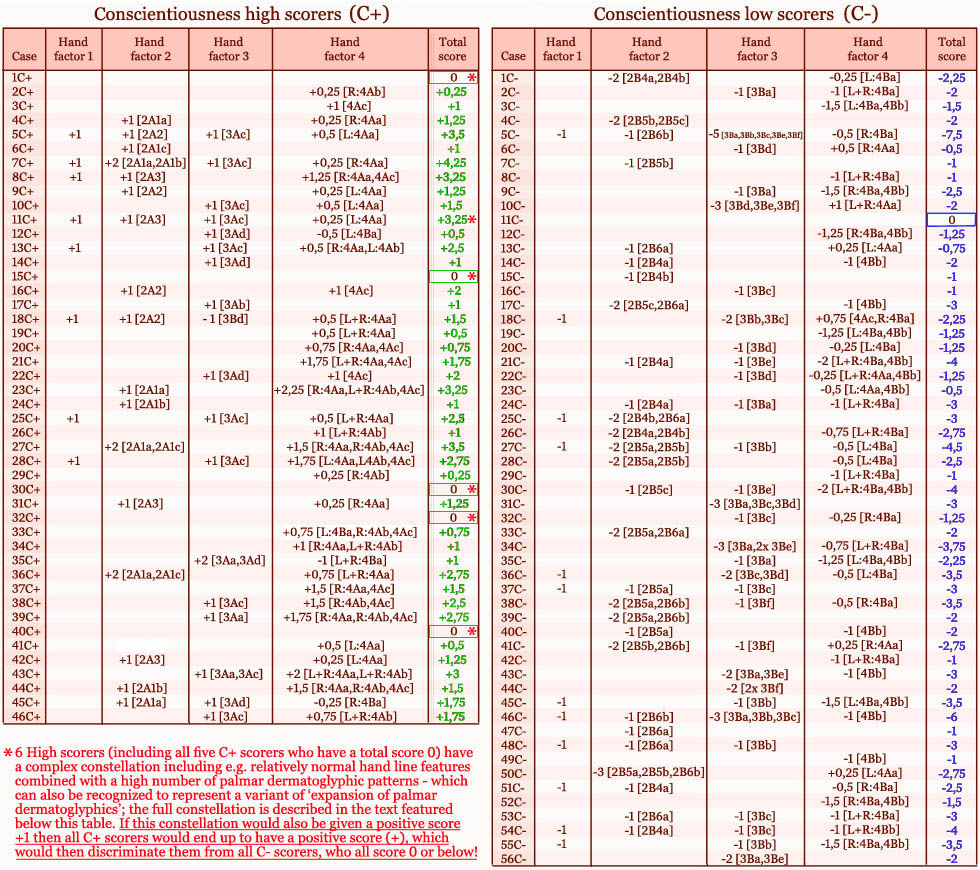
NOTICE: The full summary of the complex constellation that has been identified in the hands of 6 C+ scorers (including all 5 C+ scorers who have a total score of 0 based on just the 4 hand factors described in the preceding paragraphs):
- at least 2 palmar patterns present in at least one palm, including a hypothenar radial loop or a thenar pattern;
- an ulnar complex pattern on at least 1 ring vinger + ulnar loops on at least 5 fingers;
- a mid-axis line constellation with no more than 5 aspects in total described for hand sign 4Bb, including no more than 3 aspects in one of both hands, and aspect 4 (= mid-axis line is missing above the upper transverse line) is required to be present in at least one hand;
- both lower transverse lines have normal length, and they have a radial connection with the thenar line.
Building an advanced biometric hand model for
the Big Five personality dimension Conscientiousness:
specific requirements for males and females!
In order to illustrate the strength of the tendencies reported for the results that involve ruler measurements (which illustrates explicit how this truely represents biometry), an advanced regression analysis has been made for the hand index and the relative size of the palmar triradial zone combined for males and females separately. The regression results for the combination of these 2 measures produce values that correlate very significantly for the full population (p<0.001), and also for the females (p<0.001) and males (p=0.002) separately; this illustrates the potential signifance of these two biometric hand factors combined in isolation. This is also illustrated by a clear difference for the average ratio (hand index vs. relative size of the palmar triradial zone), because the average ratio in C+ scorers (58,05) is about 6.5% smaller compare to the average ratio in C- scorers (62,08).
The picture below provides a visual illustration for the effect-size involved with this study; the upper 5 hands concern examples of the C+ scorers that express a LOW hand index (read: narrow hand) combined with a relatively LARGE palmar triradial zone, and the lower 5 hands concern case examples of C- scorers that express a HIGH hand index (read: broad hand) combined with a relatively SMALL palmar triradial zone.
[high resolution version available HERE].
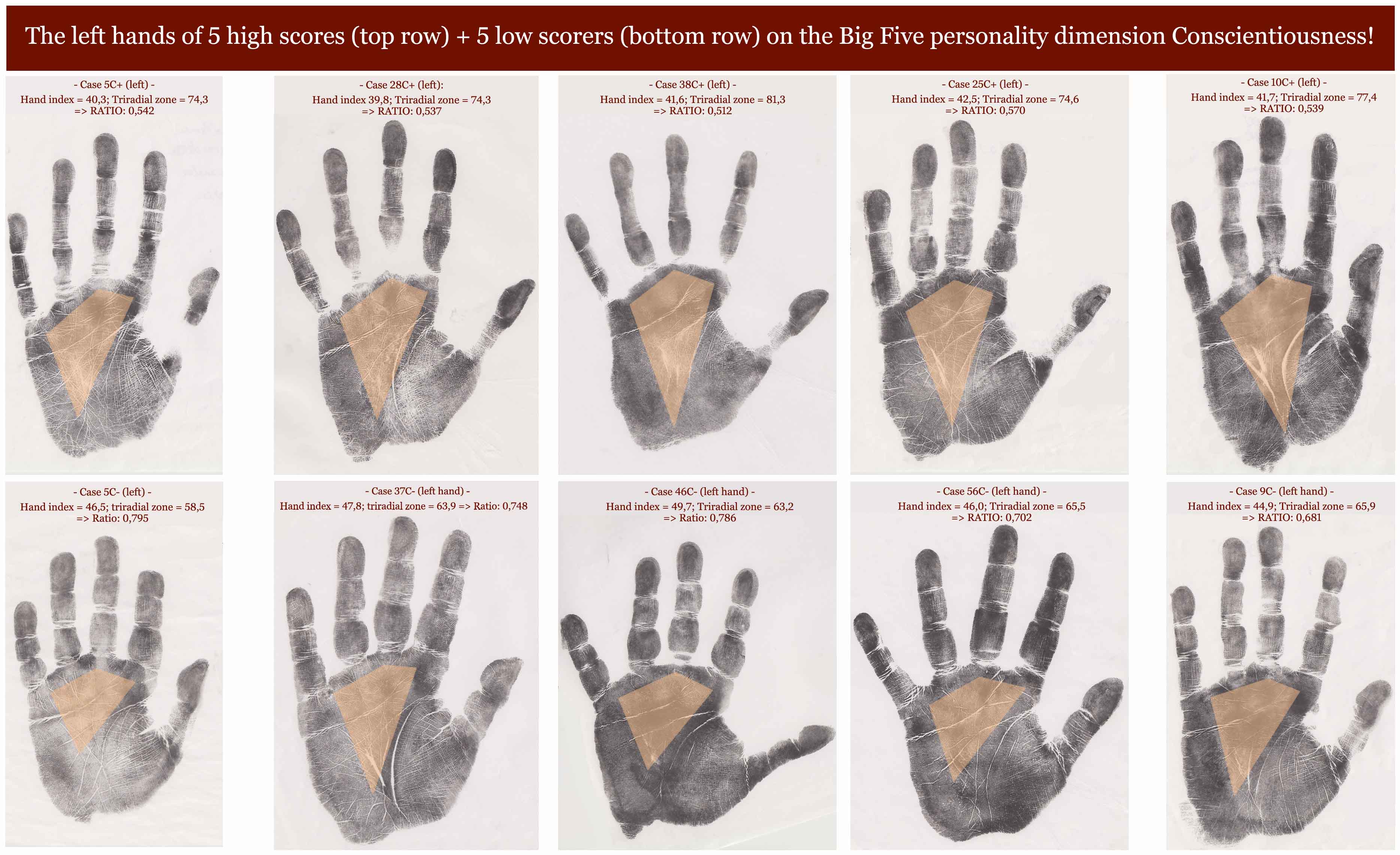
Another potential hand factor: finger phalange ratios!
Finger constellations featured with long proximal phalanges, medium middle phalanges and short distal (nail) phalanges have been identified to represent a typical characteristic in Conscientiousness high scorers - especially when such constellations are present in multiple fingers, present in 9 C- scorers, 0 C+ scorers. Also, opposite constellations have spotted much more often in Conscientiousness low scorers - especially when these constellations are present in at least 3 fingers of the same hand including the pinky finger, present in 5 C+ scorers, 0 C+ scorers.
NOTICE: Because this 5th hand factor involving the finger phalange ratios did not produce scores for the 7 cases that produce a score '0' for hand factor 1 to 4, this hand factor does not clearly improve the overall results for the studied population. Nevertheless, this hand factor clearly does have potential to serve as an additional hand factor for the hand in the Big Five dimensions Conscientiousness and for this reason this hand factor is also featured inside the phantom picture presented at the top of this article.
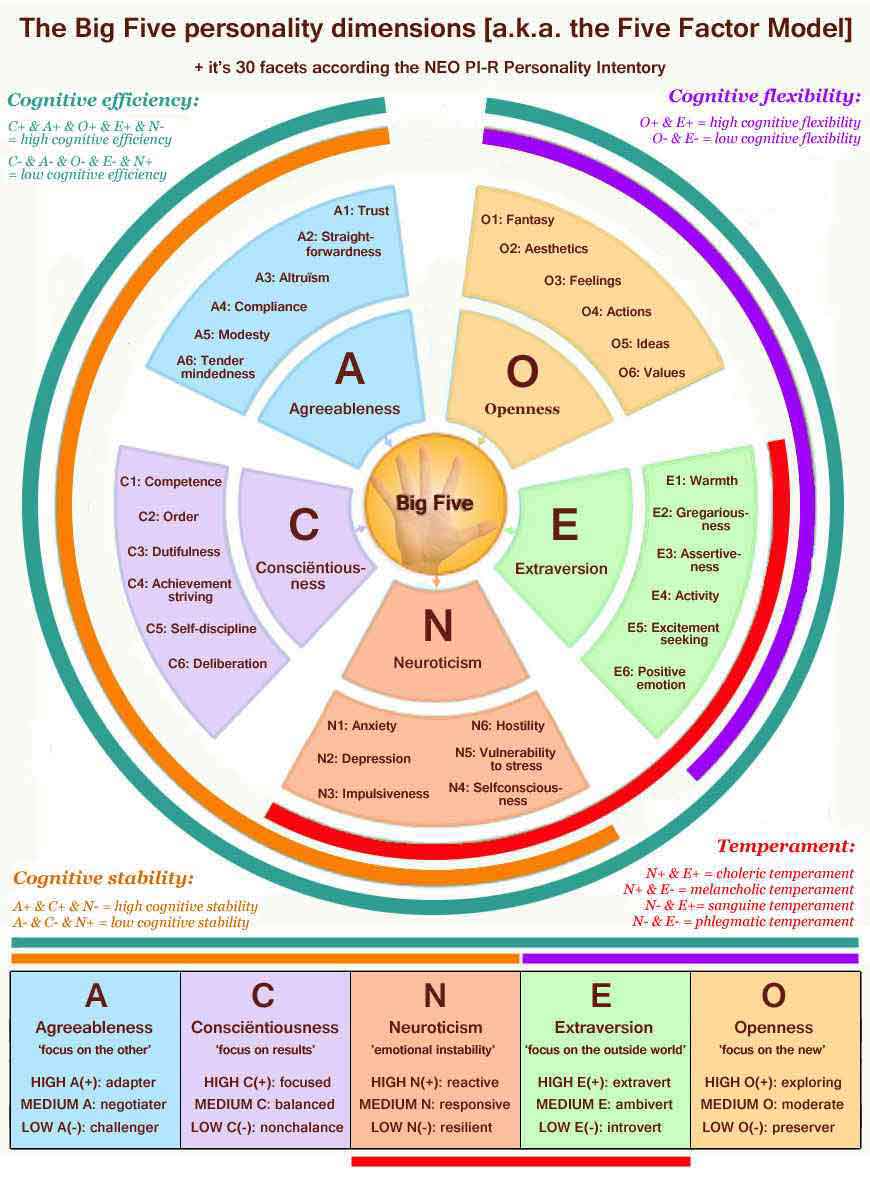
Conscientiousness represent a dimension of the Big Five model, a.k.a. the 'Five Factor Model' (FFM).
The model is designed to describe the full 'color-spectrum' of a personality, including:
the classic temperaments, cognitive stability & cognitive flexibility.
Final notification: case studies will become available in the near future; meanwhile you might want to explore
the other four Big Five dimensions Agreeableness, Extraversion, Neuroticism & Openness!
All Big Five hand charts are presented together inside the article:
Hand sign constellations in the Big Five personality dimensions.
|
|
© COPYRIGHT 2002-2017: |
